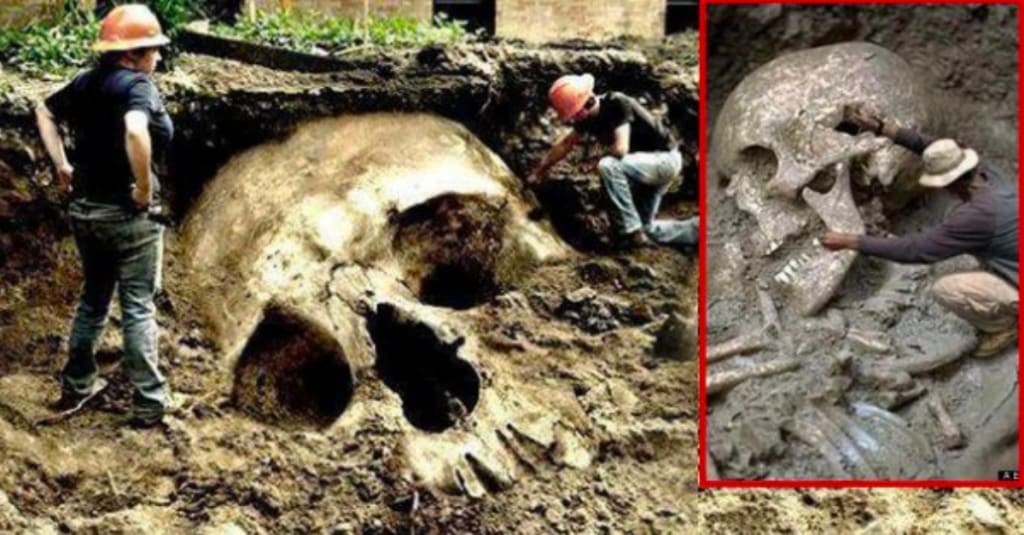A Lost City of Giants?
Unearthing the Enigmatic: Lost City of Giants in Ethiopia

Unearthing the Enigmatic: Lost City of Giants in Ethiopia
In a recent archaeological excavation in Harlaa, Ethiopia, a team led by Timothy Insoll from the Institute of Arabic and Islamic Studies at the University of Exeter made a startling discovery - a long-lost city believed to have once been inhabited by giants. This remarkable find has not only rekindled local legends but also revealed intriguing insights into the city's historical significance.
Ethiopia, a land known for its rich history and cultural heritage, continues to be a treasure trove for archaeological revelations. While past expeditions in the region primarily focused on uncovering ancient human remains, the recent dig ventured into the uncharted territory of deciphering a mysterious legend of giants that has long echoed through local folklore.
A City of Giants?
For generations, the residents of Harlaa have passed down stories and legends of giants inhabiting the region. This rich oral tradition intrigued the archaeological team, inspiring them to explore this untapped aspect of history. To lend credibility to these tales, the researchers embarked on a quest to unearth structures that could only be explained by the existence of giants.
Their findings were truly astonishing. Massive stone buildings, the kind that could only have been constructed by beings of extraordinary size and strength, stood as testaments to the local legends. The colossal stones raised questions about who could have possibly erected such structures.
Adding to the intrigue were the frequent discoveries of old coins and pottery, providing further evidence of a long-lost civilization that thrived in the area. While conclusive evidence of giants remains elusive, the discoveries in Harlaa hint at the possibility that these legends might have a basis in reality.
The city's archaeological history has so far been overshadowed by its more famous counterparts like Axum, known for its grand obelisks, or Lalibela, renowned for its rock-hewn churches. However, the revelations in Harlaa could potentially thrust this city into the archaeological limelight.
A Hub of Ancient Trade
As the excavation continued, what the archaeologists found went beyond the stories of giants. Harlaa, it seems, was not merely a city of myth; it was a vibrant trading hub, deeply connected with the rest of the world between the 10th and 15th centuries.
The findings painted a picture of a rich, cosmopolitan center, particularly renowned for jewelry production. Artisans in Harlaa created exquisite pieces that were traded throughout the region and beyond. The city's residents, a diverse mix of locals and foreigners, had extensive trade networks that extended to the Red Sea, Indian Ocean, and possibly even the Arabian Gulf.
Fragments of glass vessels, rock crystals, glass pottery, and other artifacts originating from far-flung places like Madagascar, the Maldives, Yemen, China, and Egypt were uncovered. These findings affirm Harlaa's status as a prominent crossroads in the intricate web of global trade during that era.
The establishment of Harlaa as a bustling trading center provides vital historical context. It elucidates the interconnectedness of different parts of the world during the medieval period. Such global connectivity was often underestimated or overlooked in the annals of history, yet Harlaa's archaeological treasures signify that it played a significant role in bridging cultures and commerce.
Unraveling the Mysteries
Despite the significant discoveries, the question of the existence of giants in the city remains open. While tangible evidence of these colossal beings is yet to be found, the compelling clues from Harlaa only add to the global enigma surrounding the giants of antiquity.
Archaeologists continue to delve deeper into the history of Harlaa, with ongoing investigations and the study of approximately 300 individuals from the city's cemetery. Through these endeavors, they aim to shed more light on the people who once thrived in this remarkable city.
By examining the skeletal remains and conducting meticulous analysis, researchers hope to discern the lifestyle, origins, and even the potential existence of giant individuals. Were the giants real, or did their legend originate from the remarkable structures they left behind? These are questions that the scientific community is eager to answer.
The story of the lost city of giants in Harlaa, Ethiopia, serves as a reminder of the hidden treasures that history often conceals. As research unfolds and more mysteries are unraveled, the world waits in anticipation for the next revelation that will further illuminate our past and, perhaps, finally confirm the existence of giants in our ancient history.
The Global Mystery of Giants
The idea of giants has fascinated humanity for centuries, appearing in folklore, religious texts, and oral traditions from cultures around the world. While the recent discovery in Harlaa, Ethiopia, offers tantalizing clues, it's just one piece of the puzzle in the broader mystery of giants.
Giants are often depicted as larger-than-life beings with extraordinary physical characteristics. They have been a part of human storytelling since time immemorial, from the biblical Goliath to the Greek Titans. The question of whether giants were real historical figures or mere mythological creations continues to captivate our collective imagination.
Some have theorized that stories of giants could have been inspired by the discovery of ancient megafauna remains, such as mammoths and mastodons, by early humans. The sight of enormous bones could have contributed to the development of giant myths.
In addition to Ethiopia, many other places around the world have their own giant legends. The ancient Greeks believed in the Titans, powerful and towering figures who ruled before the Olympian gods. In Norse mythology, giants were prominent figures, including the fire giant Surtr and the frost giant Ymir. These myths have left a lasting cultural impact and can be found in art, literature, and popular culture.
One of the most famous giants in history is Goliath, the biblical figure known for his duel with the young David. In various religious texts and ancient literature, giants are often portrayed as both formidable foes and complex characters.
In the realm of archaeology, intriguing discoveries have occasionally fueled the speculation about giants. Large skeletal remains have been unearthed in different parts of the world, adding to the mystery. However, such findings are often met with skepticism and debate among experts.
It's important to approach the topic of giants with a critical and scientific perspective. While the existence of giants remains a subject of fascination, conclusive evidence is required to firmly establish their presence in our past.
The recent revelation in Harlaa, Ethiopia, offers a compelling glimpse into an ancient city and its potential ties to giant legends. As researchers continue their work in this field, it's possible that we may one day unlock the secrets of these larger-than-life figures that have left an indelible mark on human culture and imagination.
The Enigmatic Giants of Harlaa: Separating Fact from Myth
The recent discovery in Harlaa, Ethiopia, has reignited the age-old debate surrounding the existence of giants in our history. While the city's archaeological findings are undeniably fascinating, they also prompt us to examine the boundary between fact and folklore.
The tales of giants inhabiting Harlaa have been a part of local traditions for generations. The sheer size and construction of the stone buildings discovered in the area indeed leave room for speculation. Were giants responsible for these colossal structures? Or is there an alternative, more plausible explanation?
One possibility is that the concept of giants may have emerged from a misinterpretation of historical evidence. As we've seen in the case of the ancient Greeks, whose myths included larger-than-life Titans, the perception of giants could have arisen from
encounters with people of unusual stature, or perhaps from the unearthing of gigantic fossilized remains.
To better understand this phenomenon, researchers must rely on rigorous scientific investigation. The study of the skeletal remains found in Harlaa is of paramount importance. By analyzing these ancient individuals, we can gain insights into their true stature, lifestyle, and origins. This could potentially either corroborate or debunk the giant theory.
Skeptics argue that our collective fascination with giants has blurred the lines between myth and reality. The human tendency to embellish stories over time has the potential to transform extraordinary individuals into mythological giants.
What is certain is that the world's fascination with giants is unlikely to wane. From biblical narratives to classical mythology, the concept of giants has permeated virtually every culture. As such, the recent discoveries in Harlaa underscore the enduring allure of these mythical beings.
The Global Impact of Harlaa's Discovery
Harlaa's significance as a rich trading hub during the medieval period cannot be overstated. This discovery challenges our understanding of the interconnectedness of ancient civilizations and highlights the global web of trade routes that crisscrossed the world long before the era of globalization as we know it today.
The finding of artifacts from distant lands, such as Madagascar, the Maldives, Yemen, China, and Egypt, indicates that Harlaa was not an isolated enclave but rather a vital center of commerce. It was a place where people from diverse cultures converged to exchange goods, ideas, and craftsmanship.
Harlaa's role as a cosmopolitan trading city broadens our comprehension of history. It illustrates that globalization and intercultural exchange are not modern phenomena but have deep roots in the past. Understanding the historical context in which civilizations like Harlaa thrived helps us appreciate the depth of human interaction and its enduring impact on our world.
The city's historical importance is not limited to the trade in physical goods. The exchange of knowledge, culture, and ideas also occurred on a significant scale. Harlaa was a melting pot of different worldviews, and its residents were exposed to diverse belief systems and traditions. Such an environment fosters innovation, creativity, and the cross-fertilization of cultures.
The ongoing excavations in Harlaa promise to reveal more about this remarkable city and its historical significance. As we explore its ancient secrets, we're also reminded of the need to approach history with an open mind, prepared for unexpected revelations and new perspectives on our shared past.
In Search of Giants
The question that continues to tantalize both researchers and the public is whether giants truly existed in Harlaa, as the local legends suggest. While the archaeological evidence in the form of giant-sized stone structures is captivating, it's not definitive proof of the existence of giants. However, the idea of giants is not confined to this one Ethiopian city.
Throughout history, giant myths have been woven into the fabric of numerous cultures around the world. From the colossal Nephilim of biblical texts to the formidable Titans of Greek mythology, stories of giant beings have transcended time and place.
One possibility is that these myths were inspired by the discovery of gigantic fossilized remains of ancient creatures. The unearthing of massive bones might have sparked the imaginations of early humans, leading to the creation of giant narratives.
Another avenue of exploration is the examination of giant skeletons and other remains found in different parts of the world. While some discoveries have fueled the idea that giants walked the Earth, these findings remain highly debated within the scientific community. Skeptics argue that factors such as gigantism or acromegaly, medical conditions that lead to excessive growth, might explain some of the historical accounts.
Despite the absence of conclusive evidence, the search for giants continues. As archaeologists dig deeper into the history of Harlaa, they hope to answer questions about the people who once called this city home. Were these residents of extraordinary size, or is the giant legend a product of the collective imagination?
The discoveries in Harlaa, along with similar findings from around the world, compel us to consider the boundaries between myth and reality, folklore and fact. They prompt us to reevaluate our understanding of history and the enduring allure of these larger-than-life figures who have left an indelible mark on human culture and imagination.
Concluding Thoughts
The discovery of a "city of giants" in Harlaa, Ethiopia, is a testament to the enduring fascination with giants in human culture. While the archaeological findings do not definitively confirm the existence of giants, they open a window into the rich history of a once-prosperous city that thrived as a global trading hub.
The giant myths that permeate cultures worldwide serve as a reminder of the human capacity for imagination and storytelling. Giants, whether real or legendary, have played a significant role in shaping our collective identity and cultural heritage.
As researchers continue their investigations in Harlaa, we eagerly anticipate the revelations that may provide insight into the city's past and the giants that may or may not have once walked its streets. In the quest to unravel this age-old mystery, we must remain open to the possibility that the truth might be more incredible than fiction.
About the Creator
Sophia Hayes
💰 Crafting Life's Stories, Poems, Fascinating Facts and Intriguing health, wealth facts await! 🌟 – A Journey Through Elegance.📚✒️
Subscribe for daily insights.
#Finance #Stories #Poetry #funfacts #WellnessWisdom 💚






Comments
There are no comments for this story
Be the first to respond and start the conversation.